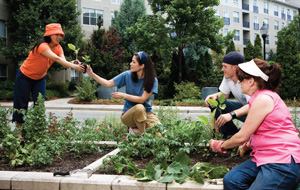ORGANIC VALUE A 2006 study from New York University found that “community gardens have significant positive effects on surrounding property values in all neighborhoods, and that those effects are substantial in the poorest of host neighborhoods (raising neighboring property values by as much as 9.5 percentage points within five years of the garden’s opening).”
Though the increase was highest in low-income neighborhoods, values in higher-income neighborhoods did improve with the addition of a high-quality community garden.
That kind of quality requires continual upkeep. In general, residents are responsible for tending the gardens, but some community managers like Post and PCM provide a landscape professional to offer advice or take over plots that aren’t kept up.
“Be ready to take it over if and when the tenants become disinterested in the project,” suggests James Ramos, partner and principal-in-charge of landscaping at Denver-based Nuszer Kopatz, a planning and design firm. “Have a back-up plan so the space can be utilized to its full potential and enjoyed by the entire community.”
In the end, beauty isn’t the only thing community gardens offer. “The intangible, creative and ecological opportunities it offers residents can be easily overlooked,” Tibbits says. “It’s a well known fact that people like to be in touch with nature, and community gardens are a great way to provide that.”
Margot Carmichael Lester is a freelance writer in Carrboro, N.C.
Resident Files Setting Roots
Thinking about installing a community garden? Consider this expert advice:
- Build in accessibility. A height of 14 inches and width of 4 feet ensures accessibility for the elderly, children, and those with physical limitations. “Raised beds are much easier to take care of and maintain the fertility,” says Eric Michiellsen, asset manager and broker for Peoples’ Self-Help Housing Corp., a nonprofit developer in San Luis Obispo, Calif. “It also helps to keep out gophers and other pests. And if the beds are raised a bit, one doesn’t have to stoop so much, which is important to seniors.”
- Establish rules. Expectations for upkeep and appearance should be made clear from the start to ensure the garden remains an asset, says Kurt Rahn, director of landscaping and recreation for Professional Community Management of California. “These rules help to shape and maintain the beauty of the community. However, keep in mind that the rules can change as the garden and the resident’s expectations mature,” he adds
- Provide support. In addition to hiring on-site staff, bring in experts to help resident gardeners improve the space and stay interested. “Other groups [can] help teach organic gardening, composting, and water conservation [so you can have] a more environmentally friendly garden free of pesticides, and for positive sustainability,” advises Jennifer Jin Brower, garden/outreach manager for Seattle’s Interim Community Development Association.
